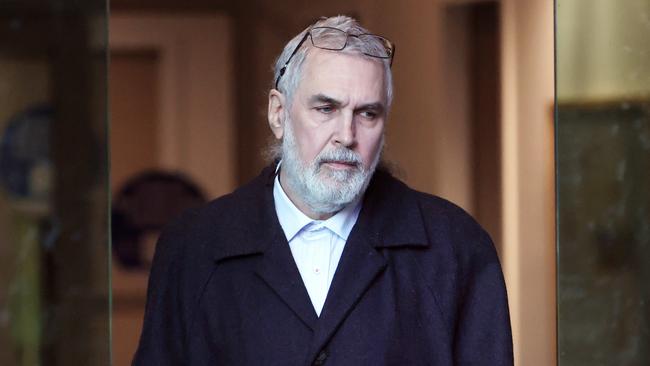Erin Patterson trial: death cap mushrooms seen near accused’s home months before fatal lunch
An esteemed fungi specialist posted photographs of death cap mushrooms found about 15 minutes from Erin Patterson’s home two months before she served lunch guests a poisonous beef Wellington.

An esteemed fungi specialist posted photographs of death cap mushrooms to an online vegetation forum two months before Erin Patterson fed her lunch guests a poisonous beef Wellington, and tagged their location in the South Gippsland region.
Royal Botanic Gardens of Victoria mycologist Tom May had told the Victorian Supreme Court he posted images of deadly mushrooms in Outtrim to the iNaturalist website in late May under the pseudonym “FunkeyTom”.
“I put a very precise latitude-longitude geocode with the observation,” Dr May told Ms Patterson’s murder trial, sitting in Gippsland.
Dr May’s comments on Tuesday followed the evidence of two medical witnesses who testified to treating Ms Patterson in the Monash Medical Centre after she hosted a lunch for four relatives of her estranged husband, Simon.
Ms Patterson is on trial in the Supreme Court for the murder of three of her guests, and the attempted murder of the fourth, for allegedly deliberately feeding them death cap mushrooms in a beef Wellington at her Leongatha home in 2023.
She has pleaded not guilty to all charges.
Dr May on Tuesday told the jury the iNaturalist website is the “largest citizen science platform for uploading observations of fungi” in Australia.
“iNaturalist is a publicly accessible website. It is where members of the public can make observations about nature. You need an account to post an observation but you do not need an account to view observations,” he said.
“iNaturalist covers all different kinds of plants, animals and fungi, and every observation on iNaturalist is an image and most of those images are associated with precise location information.”
Asked whether he had an iNaturalist profile, Dr May replied: “I do have a profile on iNaturalist and the profile name is FunkeyTom, but my name is also linked to that profile on iNaturalist”.
He said his profile also states he is a mycologist working at the Royal Botanic Gardens in Victoria.
Dr May has worked at the gardens as a mycologist for 30 years, is a fellow of the International Mycological Association and a board member of the International Commission for the Taxonomy of Fungi.
Crown prosecutor Nanette Rogers SC on Tuesday asked Dr May whether he had submitted an observation of death cap mushrooms – known scientifically as amanita phalloides – to the iNaturalist website on May 21, 2023 at 2.50pm.
Dr May said he had, and included “several photographs” and a location.
“It was in Outtrim, and I believe it would have been Neilson Street in Outtrim,” he told the court. “When I put the location in, I didn’t … I don’t think I typed the street name in but I put a very precise latitude-longitude geocode with the observation.”
Dr May said he was “giving a presentation to a local community group about fungi” on the day he made the post.
“I went for a walk and I saw these and so, as I do from time to time with different mushrooms that I encounter, I put the iNaturalist record in,” he said.
Dr May gave evidence that death cap mushrooms would likely deteriorate in the fridge quicker than store-bought mushrooms due to their exposure to tiny bugs.
“Commercial mushrooms would tend to last longer because they are not infested with insects,” he said. “So you could keep a button mushroom in the fridge for a good couple of weeks and it’s not going to start to decompose.”

Dr May also said death cap mushrooms had been detected in Loch in April 2023.
The jury has previously been told about Dr May’s iNaturalist post at the Loch sighting when Dr Rogers made her opening statement to the court.
In the opening, Dr Rogers said Ms Patterson visited Outtrim the day after the iNaturalist post was made.
“The location that he posted was within roughly 20 metres of the death cap mushroom sighting made by him. Those images that are on the screen are the images that he posted on the iNaturalist website,” she said in the opening.
“The very next day, the accused’s mobile service data suggests that she travelled to and remained in the Loch area at around 10am before returning to Leongatha.
“Later that same day, her mobile service data suggests that, having travelled to Loch between nine and 10am, she travelled from Leongatha to the Outtrim area at around 11am, before returning to Leongatha.”
Earlier on Tuesday, Monash Medical Centre emergency registrar Laura Muldoon gave evidence that the leftovers of Ms Patterson’s beef Wellington were sent in an “urgent taxi” to the Royal Botanic Gardens for inspection two days after the lunch.

Dr Muldoon told the court she had received a photo of the leftover beef Wellington from general practitioner Veronica Foote at Leongatha Hospital. The meal had then been transported to her at the Monash Medical Centre in a bag in an ambulance with Ms Patterson, she said.
“I looked inside it, clarified what the contents were, and didn’t touch or take any photos,” Dr Muldoon said.
Dr Muldoon said she then arranged for an emergency department administrative staff member to send the leftovers in an “urgent taxi” to a mycologist at the Royal Botanic Gardens.
It arrived about 7.27pm on July 31, 2023.
The Monash Health director of public health on Tuesday told the court Ms Patterson told her the mushrooms she had used in the beef Wellington had been bought from an Asian grocer and had a “strong smell”.
Rhonda Stuart said she “quizzed” Ms Patterson on the origins of the mushrooms to determine whether there was a wider public health issue.
“One of the types she said were taken from the supermarket in a container with plastic over the top, so I just assumed they were button mushrooms, like we see regularly in the supermarket, but the other pack she said she got from an Asian food shop a number of weeks prior,” Dr Stuart said.
She later added: “She did say they had a strong smell.”
The trial continues on Wednesday.





